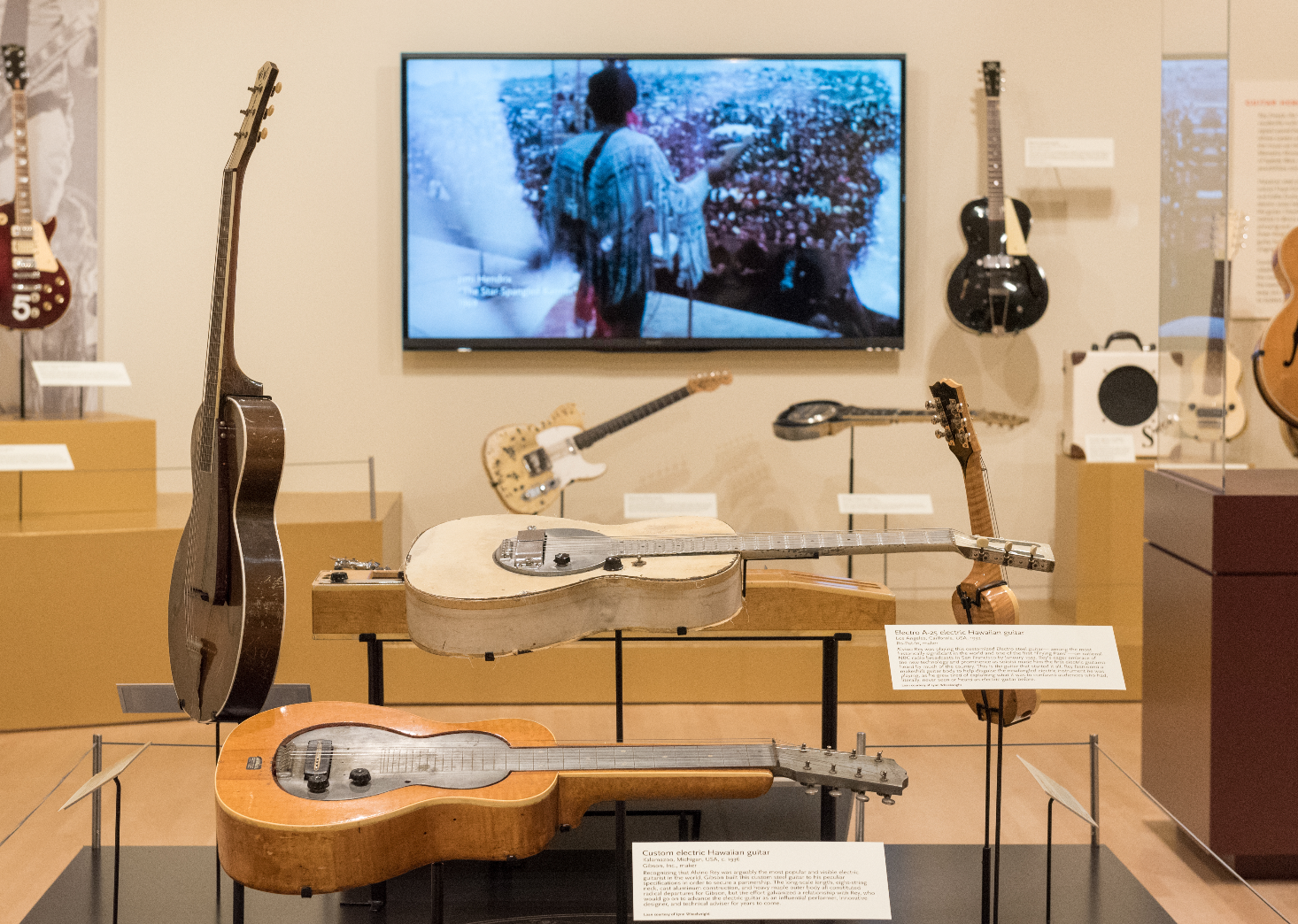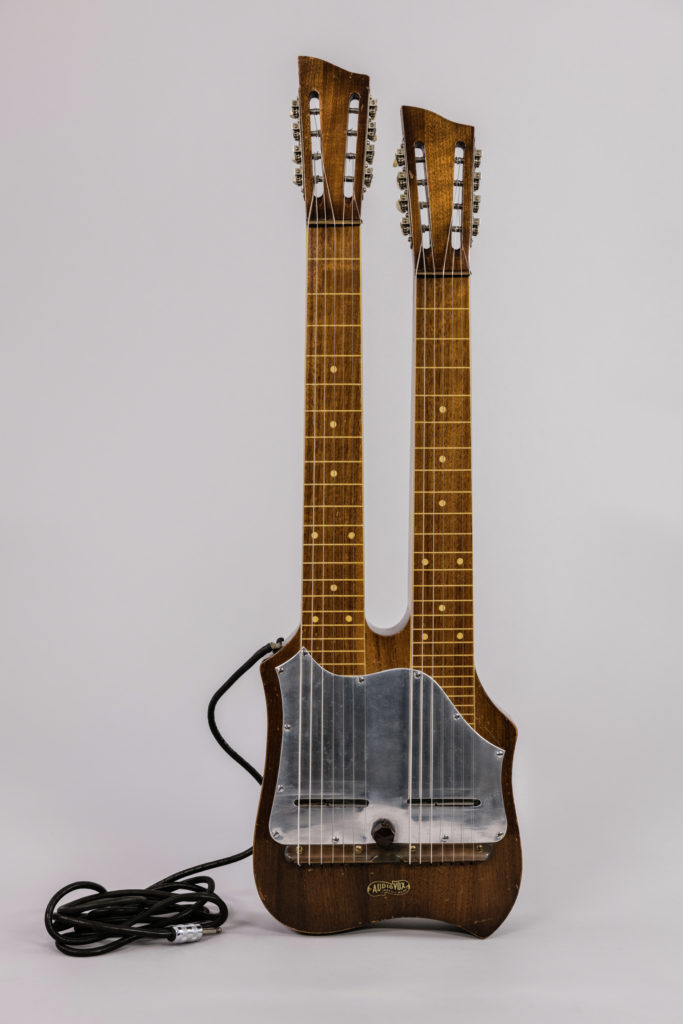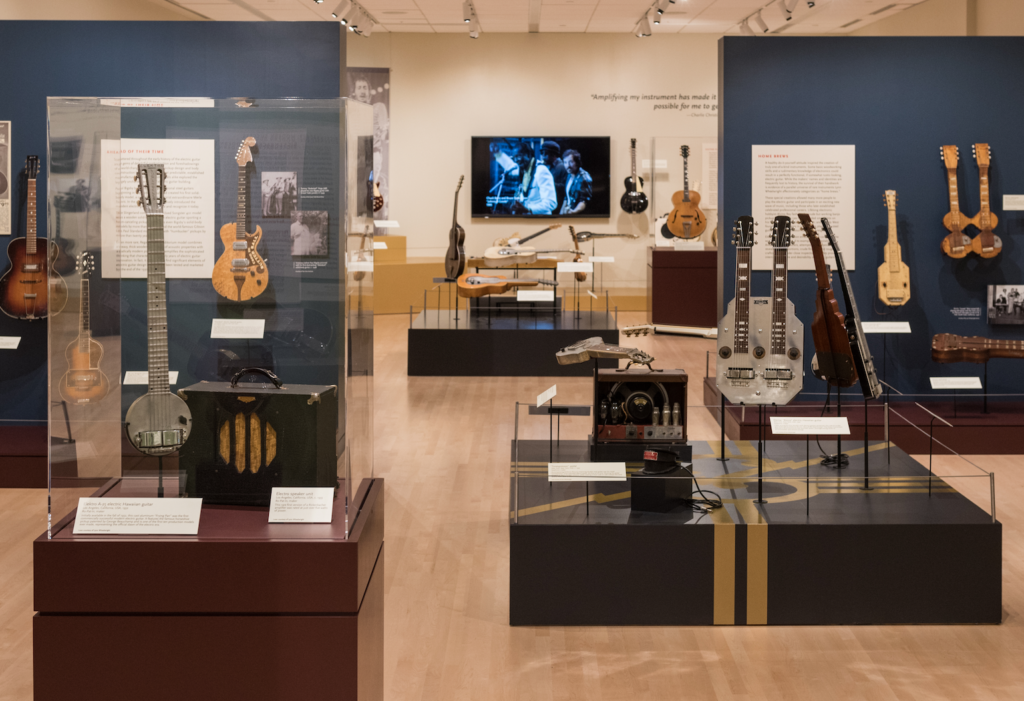It’s Electric: Amplified Strings Tell Story of Musical Innovation

Writer Joseph J. Airdo
Photography Courtesy of Musical Instrument Museum
[dropcap]S[/dropcap]tepping into the Musical Instrument Museum’s new electric guitar exhibit is like traveling through a time machine—not standing on the other side of it, but rather actually traveling through it, seeing the swirl of different eras surrounding and engulfing you. I love comparing these guitar types especially when you get to see how they have changed throughout the past century.
It is almost necessary to take a 360-degree spin immediately upon entering the doors to fully appreciate the dynamic history and cultural significance of the many stringed wonders on display before finally focusing in on one and making your way through the breathtaking exhibit.
The Electric Guitar: Inventing an American Icon, available through Sept. 15, showcases more than 80 of the rarest electric stringed instruments and amplifiers in the world. The exhibit reaches as far back as the 1930s and features the personal instruments of groundbreaking artists such as Ron Wood and Keith Richards of the Rolling Stones.
The museum has a permanent display on its second floor called “Amplified Guitars.” Dr. Richard D. Walter, Ph.D., MIM’s curator for United States/Canada and Europe, explained that this special exhibition expands upon that, concentrating on the origins of the electric guitar while also taking a look at their technology and the most innovative, pioneering figures in their history.
Many—but not all—of the items on display in the exhibit belong to guitar historian Lynn Wheelwright. MIM staff looked for highlights in Wheelwright’s private collection that allowed them to find a cohesive and coherent narrative that would be both educational and interesting for visitors. From there, three themes were selected: the technology behind amplification, the designers and manufacturers responsible for the electric guitar’s success and the influence the instruments had on music.
“The electric guitar is certainly the standard focus of the exhibition but even during the earliest moments of amplification people were applying it to anything with strings,” Dr. Walter said. “Manufacturers were building an incredible array of different instruments and offering them to the public—although some were more successful than others.”
MIM’s gallery also includes electric Hawaiian guitars, electric lap steel style guitars, electric violins, electric banjos and electric mandolins. All of these instruments influenced genres that defined American music—including Hawaiian music, dance orchestras, Western swing, jazz and especially rock and roll.
“When amplification was emerging as a new solution to these things and people realized they could amplify a stringed instrument, a lot of the earliest efforts had to do with anything that would have been in vogue at the time. People were making music and needing to play to a dance audience, social club or community event,” Dr. Walter explained. “It was an advantage for anyone to be able to play more loudly, so they were applying this technology right off the bat to virtually anything with strings.”
The highlight of the exhibition is, without a doubt, the electric guitars themselves. Dr. Walter’s personal favorite piece in the gallery is Alvino Rey’s Electro A-25, an instrument that was likely the first electric guitar ever played on a national radio broadcast.
“Alvino Rey had his hands directly in the true first developments and steps into making the electric guitar successful,” Dr. Walter said. “We’ve got six of his personal instruments on display in the gallery. It lets us say with a straight face that we are reaching back and displaying the real beginnings of this electric guitar story.”
Other notable inclusions in the collection are Charlie Christian’s Gibson ES-250, Paul Bigsby’s “Standard” guitar, Pete Townshend’s Gibson Les Paul Deluxe and Bo Diddly’s “The Bad Dude.” The gallery even features the Wrecking Crew’s session guitarist Tommy Tedesco’s main guitar.
“That guitar really might be one of the most recorded musical instruments on the planet,” Dr. Walter said. “He was such a busy studio musician and played for TV shows, film scores and all kinds of hit records with artists ranging from the Beach Boys to Frank Sinatra to Simon and Garfunkle. That’s an instance of one of these instruments that virtually every person who walks into that gallery has heard thousands of times.”
To help illustrate the story, The Electric Guitar: Inventing an American Icon features an original video production that appears on displays within the exhibit. Interviewees include Wheelwright, Grammy Award-winning jazz guitarist George Benson, and Sandra Boggs, daughter of late country steel guitarist Noel Boggs and goddaughter of Leo Fender—founder of one of the most successful electric guitar manufacturers in the world.
“You’re not just seeing static instruments, but you’re actually getting to see how they’re held, hear how they sound and see what the people look like who played them,” said Dr. Walter, noting that Tommy Tedesco’s guitar is accompanied by a monitor that plays samples from the “Bonanza” and “Twilight Zone” themes to drive home the instrument’s significance and recognizability.
Dr. Walter added that working on the exhibition and seeing all of the earliest efforts has taught him that, for as relevant and contemporary as the electric guitar still is, the people who first attempted to amplify the stringed instruments got it right and were sophisticated in their thinking.
“There haven’t been any especially significant improvements or changes to the electric guitar since the 1930s,” Dr. Walter explained. “It has been fun to realize just how exciting and sophisticated the music was as well. It didn’t take years to turn into rock and roll. People were playing radical, exciting music as soon as they had their hands on these amplified guitars.
“These are 80- to 90-year-old designs but they look modern if not futuristic still today. It’s really fun to see the original versions of those instruments and realize that people were way ahead of their time—both in the concept of amplification and in the design.”
The Electric Guitar: Inventing an American Icon
Through Sept. 15 | 9 a.m.–5 p.m. | Musical Instrument Museum | 4725 E. Mayo Blvd., Phoenix | $7 | 480-478-6000 | mim.org




